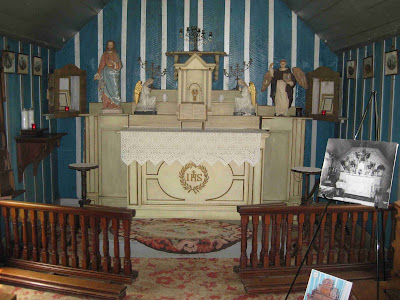Rancho Camulos exists out of time. To visit it is to escape into the past – not into history, but into romance. This is the embodiment of the California dream… a fresh water spring in the desert wilderness. It is whatever people want it to be. Like Hollywood. Like Ramona’s story itself. What most people remember about Ramona is not the title character’s identity crisis (as a half-breed Native American raised to think she's a Spaniard), but the idealized setting of her childhood: golden afternoons in endless mustard fields. On a clear day, you can see forever. And every day is clear. Author Kevin Starr explains:
“It was, obviously, a mythical time and place, a garden of earthly delight which in truth had never existed with such sensuous and imaginative fullness, although its inspiration, Rancho Camulos, was among the most beautiful places in Southern California. As a myth, however, Ramona’s ideal Southland gave expression to a yearning that Southern California be a land of beauty and memory and sunny afternoons. The pastel ideality of Ramona’s local was a way of suggesting that the frontier was over, that aesthetic self-consciousness had come to California del Sur.”
It was also a fantastic sales pitch, drawing new arrivals and tourists by the thousands, as Carey McWilliams points out: “Picture postcards, by the tens of thousands, were published showing ‘the school attended by Ramona,’ ‘the original of Ramona,’ ‘the place where Ramona was married,’ and various shots of the ‘Ramona Country.’ Since the local chambers of commerce could not, or would not, agree upon the locale of the novel - one school of thought insisted that the Camulos rancho was the scene of the more poignant passages while still another school insisted that the Hacienda Guajome was the authentic locale - it was not long before the scenic postcards depicting the Ramona Country had come to embrace all of Southern California. In the ‘eighties, the Southern Pacific tourist and excursion trains regularly stopped at Camulos, so that the wide-eyed Bostonians, guidebooks in hand, might detrain, visit the rancho, and bounce up and down on ‘the bed in which Ramona slept.’”
The school is still there, as is the chapel used in the 1920 film adaptation with Mary Pickford. (FYI – Ramona was married in Temecula.) The ranch house has seen better days – the adobe structure was badly damaged in the 1994 Northridge earthquake – but it is still a beautiful discovery and a wonderfully peaceful setting. The docents have made up a room to look like Ramona’s bedroom – since tourists still demand to see “the bed in which Ramona slept.” (I took a requisite photo through a murky glass window, but it didn’t turn out… so you’ll just have to go see it for yourself.) Very recently, the fountain on the front lawn has been restored, and the sound of trickling water adds to the experience of the place... You can close your eyes and easily imagine that you’re standing in Old California.
And what’s a place like this for, if not to stir the imagination?
About six months ago, we visited a similar ranch in Long Beach. Rancho Los Cerritos also dates back to the Spanish and Early Mexican Era, and its 19th century history is accessible through firsthand account in Sarah Bixby Smith’s memoir Adobe Days. The main adobe house was built around 1844 and the author spent her childhood within those walls. Reading her memoir is a bit like listening to the fountain in front of Rancho Camulos. Set against the chaos of contemporary Los Angeles, it puts one at ease. Both of these historical ranches are well worth a visit.






 Photo taken in Palos Verdes, March 2008
Photo taken in Palos Verdes, March 2008 Photo taken in Palos Verdes, March 2008
Photo taken in Palos Verdes, March 2008 Rancho Los Cerritos
Rancho Los Cerritos Rancho Los Cerritos
Rancho Los Cerritos
No comments:
Post a Comment